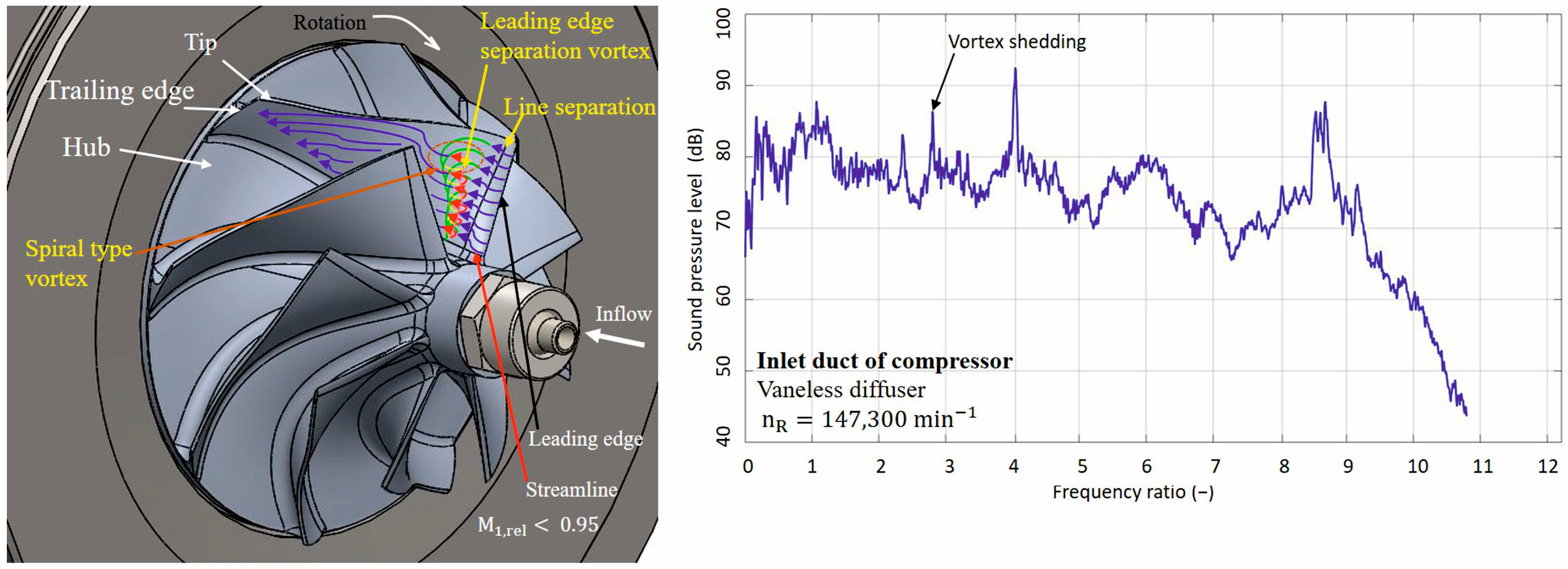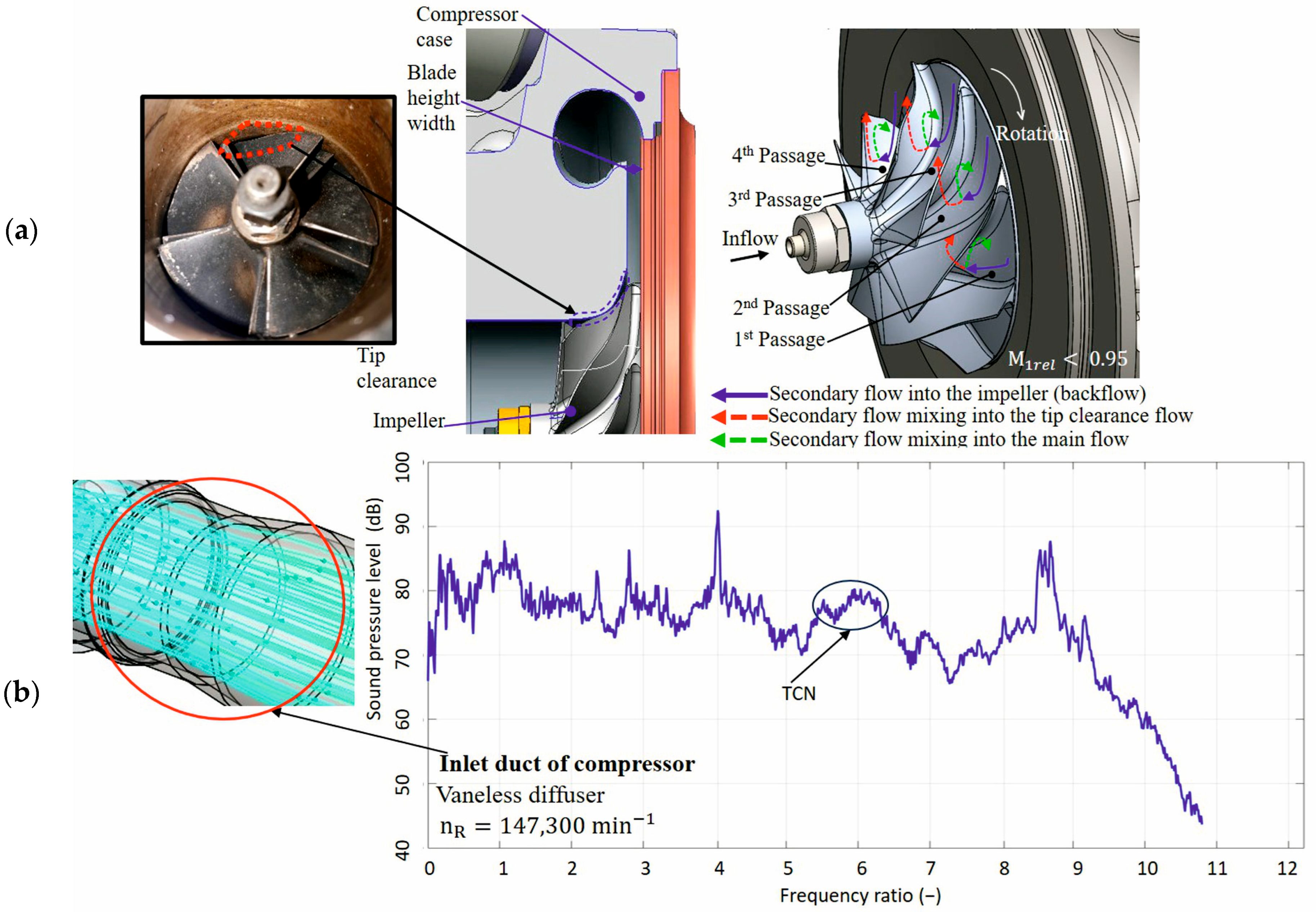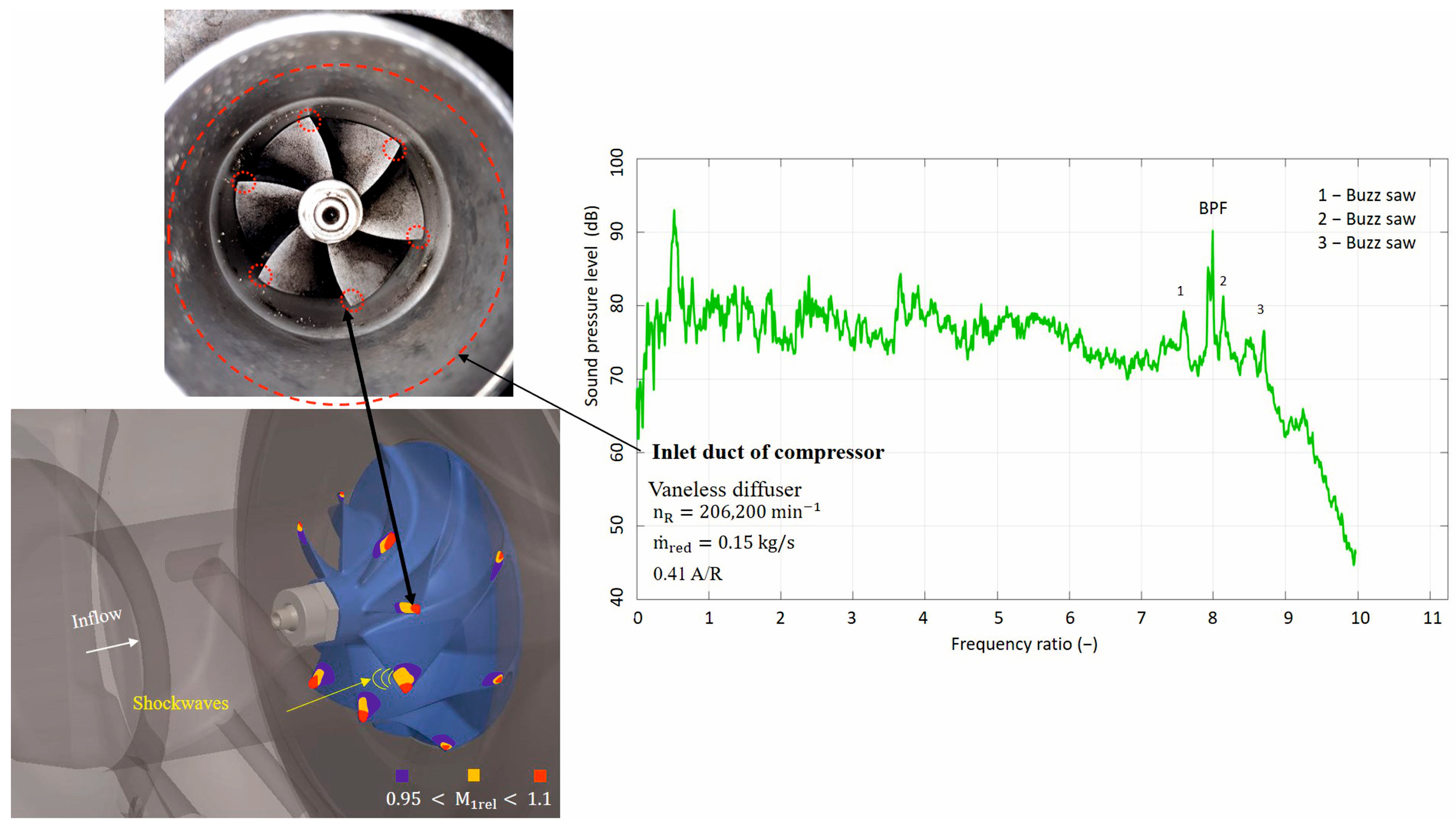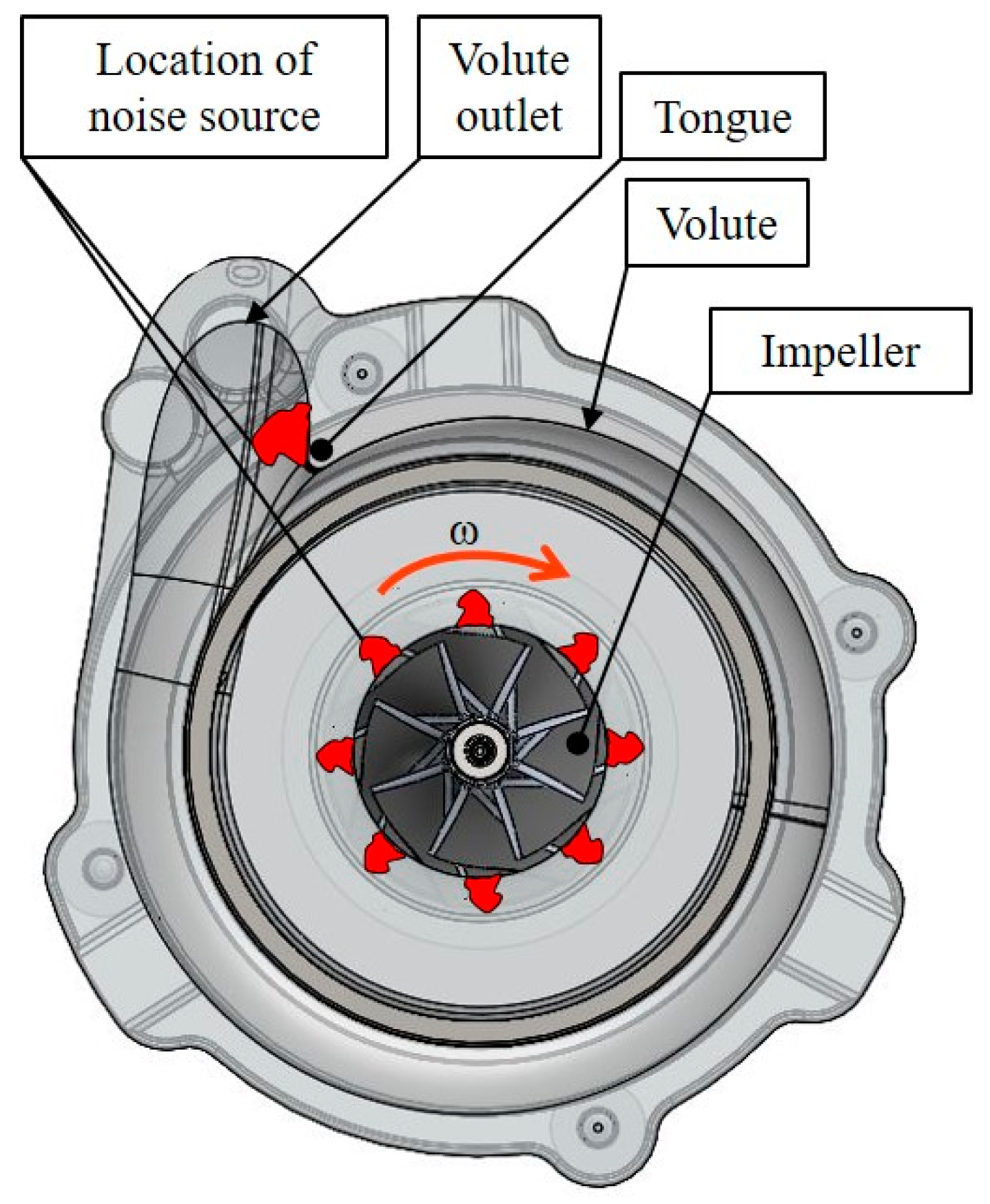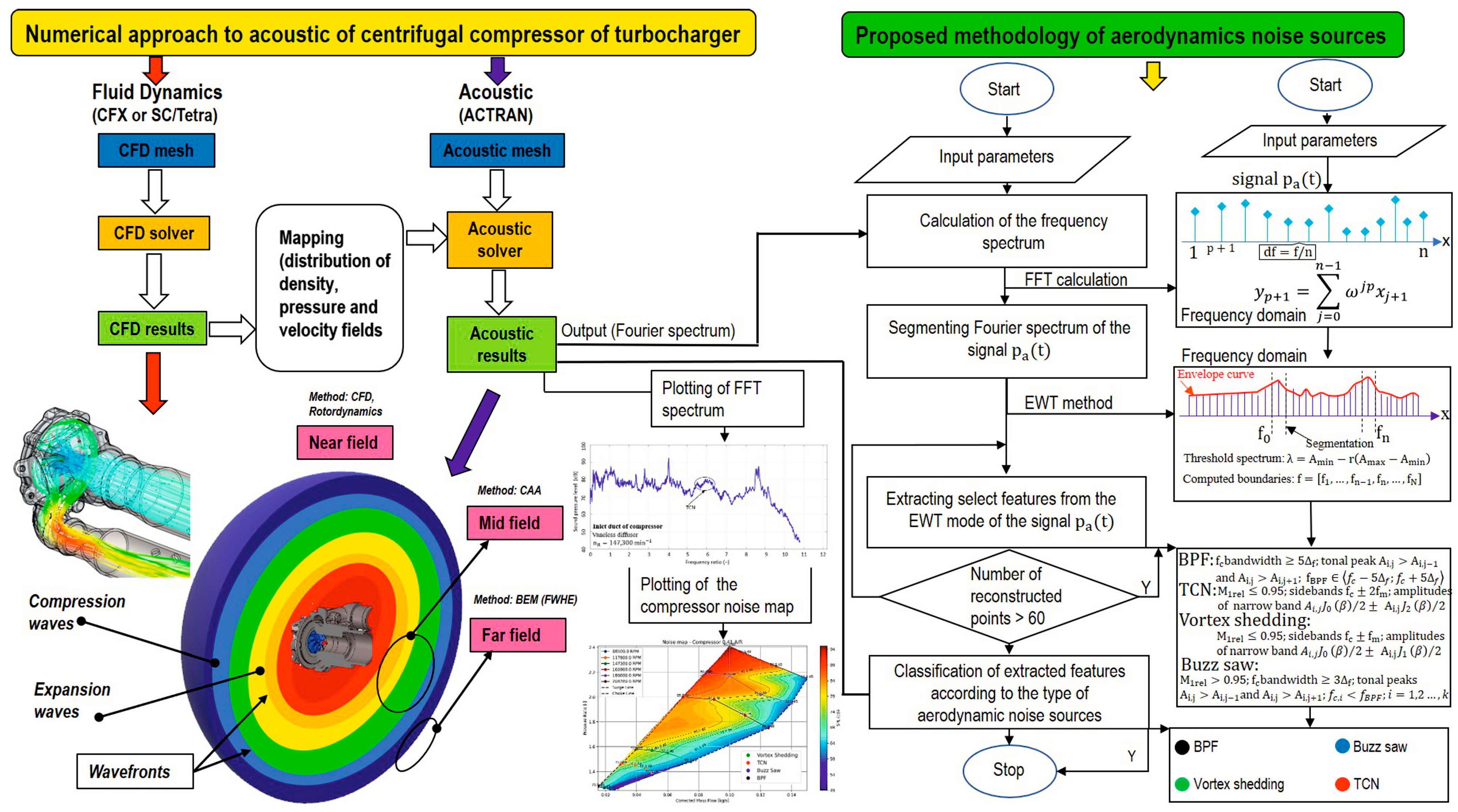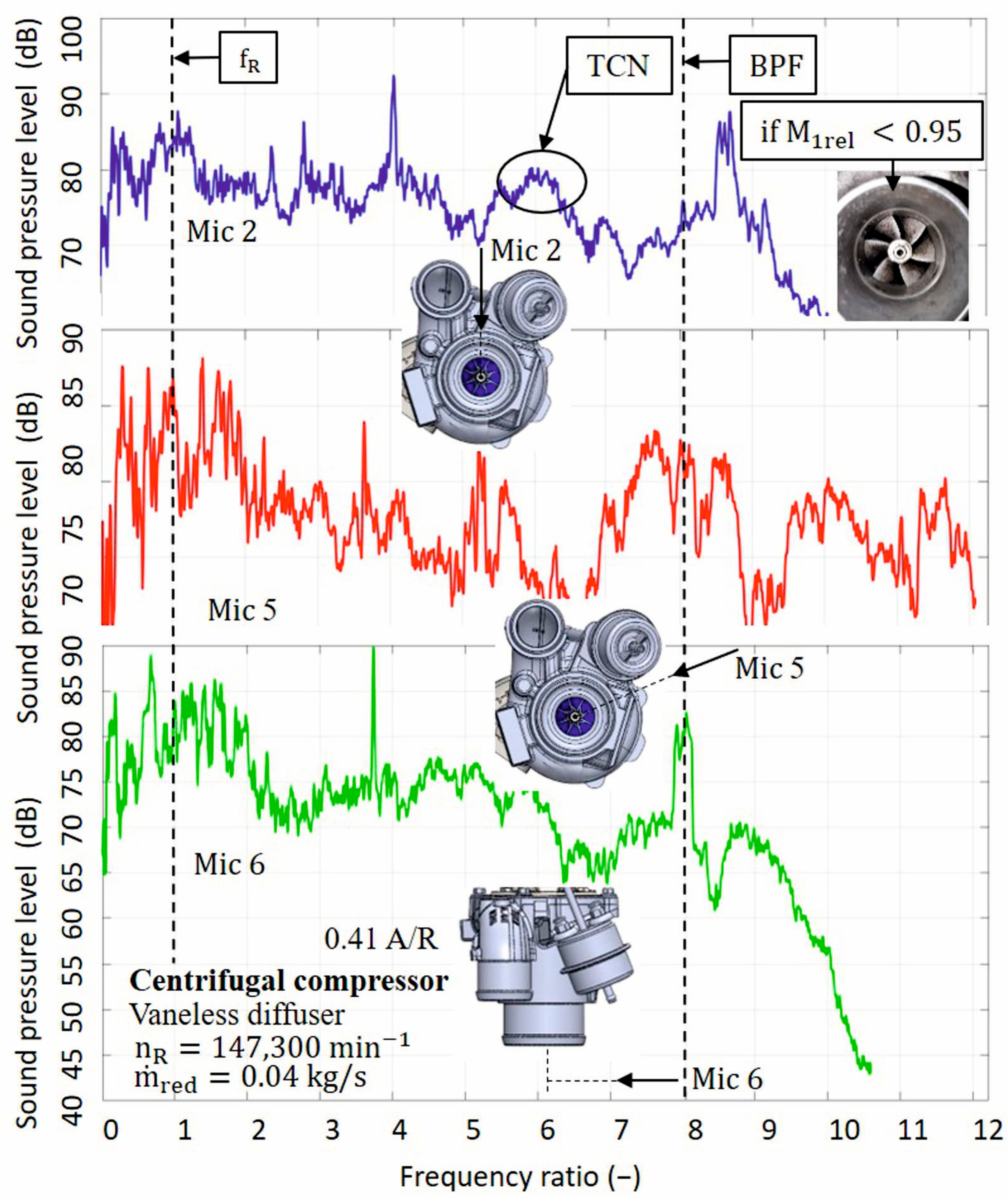The occurrence of individual sources can be assessed with respect to the current operating point in the compressor characteristic, but also with respect to boundary conditions. The compressor parameters, such as mass flow rate, pressure ratios, and rotation speed of the compressor revolutions, are considered in the assessment. Another parameter used is related to the achieved value of the Mach number, or to the speed of the flow of the working medium in the flow parts of the centrifugal compressor. Due to the geometry of the impeller, it is possible to define an area with the specified speed on the tip edges and leading edges of the blades in the inlet section of the wheel.
In a centrifugal compressor, aerodynamic phenomena occur during operation, which can be characterized by the frequency of the investigated phenomena
f. Various quantities can be used to identify the investigated frequency, such as oscillation, sound, acting force, etc. In the case of rotary machines, which also includes a centrifugal compressor, a basic parameter in the frequency domain can be defined as the rotor rotation frequency
fR. In most cases, the specified frequency is used as a quantity to which the frequencies of aerodynamic events can be constructed. Flow instabilities arising in a centrifugal compressor can be expressed by the rotation frequency of the pressure fields
fS, respectively, and by the number of these fields
n. The number of pressure fields can also be marked as stall cells. The resulting aerodynamic event, which is in relation to the selected position of the stationary coordinate system, is defined by the excitation frequency written in the following form:
Another typical frequency that is related to centrifugal compressors and the number of impeller blades defines the blade frequency as follows:
where
zR defines the number of impeller blades. In the case of centrifugal compressors, the impeller may contain main and splitter blades. On the basis of the above, the blade frequency of splitter blades occurs in the frequency spectrum. An aerodynamic phenomena whose excitation frequency can be put into relation with the selected frequency for a certain rotating machine can be expressed by the frequency ratio
ε. In most cases, the rotation speed or synchronous frequency is used for comparison, and, subsequently, the rotation speed ratio of the mentioned event can be defined as follows:
The rotation speed ratio can reach arbitrary values. In general, for sub-synchronous events is
εR < 1, while for super-synchronous events it is
εR > 1. The frequency of rotation of pressure fields
fS is often referred to in the literature under different designations. For the purposes of the publication, the value
fS is used in order to define the frequency ratio of rotation of pressure fields, as in the following Equation (4):
where
εS reaches a typical value of less than 1.
2.1. Vortex Shedding Phenomena
From the point of view of the centrifugal compressor, noise sources arise, which are caused by the constant flow of the working medium, sudden changes in pressure, and the formation of a secondary flow of the working medium. The working medium enters the compressor in the axial direction and gradually passes through individual channels between the blades of the impeller, which rotate at a certain speed. The aerodynamic phenomena that occur during the operation of the centrifugal compressor are related to the speed achieved at the inlet to the compressor. Based on the above, the event can be characterized as vortex instability occurring on the leading edge and on the edge of the blade near the wall. Forming vortices at the entrance to the impeller predict the onset of a possible rotating stall. The aerodynamic phenomena is referred to as the vortex shedding. The vortex shedding phenomena occurs as a result of Kelvin–Helmholtz flow instabilities. The phenomena formation mechanism can be defined as flow instability in the channel between two impeller blades. The shear layer of the medium is significantly unstable at the interface between the main stream and the region of the separated stream with low momentum. A low-momentum flow region appears at the blade leading edge location due to layer separation. A relative velocity with zero value is reached in the region. Subsequently, the separated flow moves towards the wall.
As the separated stream moves further, momentum is transferred between the separated stream and the main stream. The transfer of momentum between the stream generates a vortex in the region of the stream with low momentum. The generated vortex expands and is included in the mainstream. Hence, the phenomena is characterized by a time period, and another low-momentum region is created at the location of the blade’s leading edge. If a certain intensity of velocity gradients in the shear layer is reached in the region with low momentum, a new vortex is created. In the case of the mentioned instabilities, it is assumed to occur in the area of the impeller, in the area of the inlet and outlet of the impeller, and in the area of the diffuser and vaneless diffuser. Equation (3) can be used to determine the excitation frequency of the phenomena. In the case of the rotation speed line with the lowest value of the compressor speed, the noise was observed at 2× the rotation frequency of the rotor [
24].
Dorney and Davis [
25] also expressed a similar opinion about the mentioned phenomenon and labeled the mentioned phenomenon as vortex shedding. In accordance with the assumptions in the study [
24], they established an expression for the mentioned phenomenon in the frequency domain, also in relation to the blade frequencies of the compressor impeller. The vortex shedding detected in the assumed solution was a time-periodic domain with a frequency equal to the frequencies defined by the impeller rotation speed, the number of blades, and 6π. The blade frequency was three times higher than the phenomena frequency [
25]. The assumption that the vortex shedding phenomenon occurs at the inlet of the leading edge and the trailing edge of each impeller blade of a centrifugal compressor, and that the phenomenon is a result of Kelvin–Helmholtz instability, was stated by Bousquet et al. [
26]. The fact that the vortex shedding phenomenon resulted from the Kelvin–Helmholtz instabilities that occur in all impeller blade channels is not surprising. Indeed, the origin of this mechanism came from the separation of the boundary layer that formed on the surface of the suction side of the impeller blade, causing increased formation of a low-momentum flow region. The increased formation of the low-momentum flow region affects all impeller blades. The vortex shedding expression with respect to the frequency ratio was defined by [
25] based on experiments, where they observed a peak corresponding to the described phenomenon, which Bousquet et al. [
26] defined as
εR = 6.
This phenomenon is mostly explained by a periodic process of separation of vortices from the leading edge of the blade induced in the direction of flow, but there are no overall separating vortices [
27].
Figure 1 shows the expected formation of the vortex and the flow around the leading edge of the blade.
From the point of view of the vortex shedding phenomenon, it was found that the emergence of the phenomenon can be defined through Kelvin–Helmholtz instabilities. Chen [
24] described the instability for the compressor impeller as follows. Kelvin–Helmholtz instability refers to shear layer instability. A large velocity gradient across the shear layer makes the layer unstable. There is an increased occurrence in the impellers of centrifugal compressors, and the phenomenon occurs near the leading edge when the mass flow of the compressor is reduced. The generated flow passes from the tip of the leading edge of the discharge side of the blade to the suction side of the blade. This separating flow is highly whirling and moves at a different velocity than the surrounding fluid flows, creating an unstable shear layer. The author defined the described event through the frequency of excitation, i.e., as twice the frequency of rotation of the rotor. In [
24], the author developed a study of the vortex shedding phenomenon for a centrifugal compressor with the mentioned parameters.
The occurrence of the shedding vortex phenomenon is related to the speed value in the inlet part of the compressor impeller. Dorney and Davis [
25] reported the value of the achieved velocity of the working medium during the experiments. In the experiments, the inlet flow in the axial direction was considered, and the velocity value in the inlet part to the impeller reached the value
M1rel = 0.12 [
25]. Based on the set definition of the event through the excitation frequency, the expected frequency can be expressed according to [
24,
25,
26,
27] in the range (0.33–0.5)
fBPF (see
Table 1).
2.2. Tip Clearance Phenomena
Another aerodynamic source of noise related to the continuous flow of the working medium in a centrifugal compressor can be designated as TCN. The occurrence of the TCN phenomenon can be related to the clearance value between the tipping edges of the impeller blades and the wall of the compressor casing. This is one of the sources of the noise of the centrifugal compressor. In the case that TCN occurs, the mass flow rate at the inlet to the compressor is lower than the proposed flow rate. It follows from the above that at a certain clearance value, a secondary flow accompanied by vortices occurs during compressor operation conditions. Vortices formed from the secondary flow are generated through radial pressure gradients in the impeller region. The clearance between the tipping edges of the blades and the casing wall defines the part of the flow field in which the working medium reaches a low value of momentum. Due to the influence of radial pressure gradients, the medium with low momentum cannot follow the main direction of the vortex flow; thus, it turns back to the area with a lower pressure value. During the rotation of the medium to the area with a lower pressure value, the formation of spirals vortices and of a leaking flow may occur.
The aerodynamic noise source described can be identified if the supersonic velocity is not reached during the operation of the centrifugal compressor. Raitor and Neise [
8] stated the assumption that
M1rel < 0.95, which is related to the operation of the centrifugal compressor at subsonic velocity and the formation of TCN. In general, this is the resulting secondary flow that flows back towards the inlet, due to the gap between the edges of the impeller blades and the wall of the compressor casing. The source of TCN can be identified in a radial centrifugal compressor in the inlet section of the compressor. In the inlet part of the compressor, a dominant noise source of TCN occurs at a lower rotation speed and subsonic velocity [
8,
24]. Similarly, it is possible to prove the occurrence of TCN in a radial compressor in the outlet pipe, but only if the conditions of the velocity and rotation speed of the compressor are met. The occurrence of TCN in the outlet pipe is significantly influenced by the use of a diffuser. The excitation frequency of the TCN can be determined as follows:
where
εR = (0.36–0.64)
zR, as defined by [
8].
Specific factors significantly influence the appearance of the mentioned source of noise in the centrifugal compressor. Among the factors are the design dimensions determining the size of the clearance between the tipping edges of the blades and the wall of the compressor casing. The value of the clearance is further influenced during rotation by the deflection of the blades by centrifugal forces, thermal expansion, but also by the stiffness of the bearing system of the impeller.
In a wide range of rotor rotation speeds with subsonic flow conditions, the radial compressor is dominated by tip clearance noise, which is produced by secondary flow through the clearance between the rotor blade tips and the casing wall, which, in turn, leads to the phenomenon of rotational instability observed earlier in axial flow machines. The mentioned phenomenon related to the formation of secondary flow was defined by [
8] in the frequency domain through Equation (5).
Galindo et al. [
28] stated assumptions in relation to the conditions for the formation of TCN. The tip clearance noise (TCN) dominated the BPF tone for subsonic flow conditions at low compressor speeds. TCN is a narrowband sound observed at frequencies around half the blade passing frequency (BPF) that increases with rotation speed. Alqaradawi et al. [
29] reported on the generated flow through the clearance between the compressor casing and the blade tipping edges. The vortex structure, which was already formed from the leading edge, gradually passed over the tipping edge of the blade, which also confirms the shape of the streamlines [
28]. The process of TCN formation in a centrifugal compressor was described by Swamy and Pandurangadu [
30]. The TCN in the centrifugal compressor caused leakage of pressurized fluid from the pressure surface to the suction surface of the impeller blade, resulting in a complex flow field and affecting performance.
Towards operating conditions characterized by low mass flow, the time-averaged pressure fields bound to the rotor blades are more asymmetric. This will increase the broadband acoustic sound level by approximately 2–4 dB. The change can be observed in static interference modes at all frequencies. The point spectra of sound pressure level (SPL) show narrowband characteristics in this frequency interval, i.e.,
εR > 1 [
31]. The noise of TCN was identified in the range of spectra in the range (0.5–0.9)
εR [
32]. Experiments confirm the existence of a tone at approximately 70% of the rotor rotation frequency at the indicated operating point. We attribute this to the failure caused by tip clearance and rotating stall [
20].
In the case of the comparison of centrifugal compressors when evaluating the TCN noise source, the relative tip clearance parameter is introduced. In prior studies [
30], researchers defined the relative value of tip clearance as the ratio of the clearance of the wheel blades t and the width of the blades at the exit from the impeller
b2 by the equation
t/
b2. The ratio defining the clearance tip was expressed as a percentage. Parameters
t and
b2 express the relative tip clearance, and their position in the compressor is shown in
Figure 2a. The relative tip clearance is used for the purpose of assessing the impact of different designs of the compressor in terms of performance and, at the same time, in terms of generated values of sound pressure levels. With an increased tip clearance value, a significant pressure difference occurs between the suction and pressure side of the impeller blade. The described pressure difference causes a secondary flow in the compressor during operation. The direction of the secondary flow in the impeller is shown in
Figure 2b.
Identification of the TCN sound source in centrifugal compressors requires certain assumptions that have been presented in previous publications [
8,
19,
27,
28,
29]. From the point of view of the operating condition of the compressor, TCN itself dominates at lower operating rotating speeds. At the mentioned compressor speeds, a secondary flow is created, which passes through the clearance between the tipping edges of the blades and the wall of the compressor. The passing secondary flow generates a narrowband sound. At high compressor speeds, TCN cannot be identified. Compressor parameters from individual studies are presented in
Table 2, which are used for TCN identification purposes. On the basis of research from prior publications, it is possible to assume the formation of TCN in centrifugal compressors at subsonic velocities. This was the value of the relative velocity of the working medium in the input part of inducer of the impeller, respectively, at the tipping edges of the inducer. When the phenomenon occurred, it was necessary to consider reaching subsonic velocity in the described location with a defined condition
M1rel < 0.95, which is confirmed by previous studies [
8,
27,
31]. On the basis of the set definitions of the phenomena, the expected frequency of the phenomenon can be expressed according to [
8,
19,
27,
28,
29] in the range (0.3–0.9)
fBPF through the excitation frequency.
In the case of comparing the range of the predicted frequency of the vortex shedding phenomenon and the range of the frequency of the TCN phenomenon, the values overlap. This is the maximum range value for the vortex shedding phenomenon and the minimum range value for the TCN phenomenon. Both phenomena can be estimated in the above overlapped ranges. When identifying the TCN phenomenon, one can consider frequency values that are in the frequency spectrum bounded by a narrow band. The band in the frequency spectrum defines the frequency range in which the identified TCN frequency is located. When identifying the vortex shedding phenomenon, one can consider the frequency values that appear in the frequency spectrum as one separate value.
2.3. Buzz-Saw Phenomena
In a centrifugal compressor, in addition to the vortex shedding phenomenon and the TCN phenomenon, from the point of view of aerodynamics, one more phenomenon generating noise can be identified. If, during compressor operation, supersonic velocity is reached at the tipping edges of the inducer and at the tipping edges of the impeller at the output, respectively, the condition of
M1rel > 0.95 is met, it is possible to define another aerodynamic phenomena under the described conditions. For example, if supersonic conditions occur in a compressor, the dominant frequency of the acoustic sound is caused by the blade passing frequency and its multiples [
32]. The event described is expressed by the excitation frequency. Equation (3) can be used to determine the excitation frequency. The calculation of the frequency ratio
εR for the buzz saw source, which enters Equation (3), defines the phenomena as super-harmonic. In the case of the acoustic spectrum, taking into account the aerodynamic assumptions, what is known as a buzz-saw occurs.
In terms of the assumptions of the generated aerodynamic phenomena in a centrifugal compressor, Sharma et al. [
32] conducted research on this subject. Low-speed operation corresponded to subsonic conditions dominated by TCN as a narrowband sound. A narrowband sound was identified at approximately half the BPF. At higher operating speeds corresponding to transonic conditions, the spectrum was dominated by buzz-saw tones and BPF. Under specific operation conditions, shock pressure waves occurred in the area of the channels of the rotating blades of the impeller, which caused harmonic oscillations of the wheel. The process of the pressure waves reached the character of a saw shape. The occurrence of the noise source was directly related to the achieved velocity in channels with a value of 0.95 <
M1rel < 1.14 according to [
32].
The main source of the buzz-saw noise was the pressure fields of the rotor itself, which were stable in the reference frame of the rotor, i.e. pressure fields bound to the rotor. At supersonic velocity, peaks the locked rotor pressure fields were controlled by shock waves bound to the blades. The pressure field of the rotor itself propagated upstream in the inlet pipe [
8]. Sharma et al. [
32] presented the assumed parts of the impeller blades, which are characterized by reaching supersonic velocities during the generated of the buzz-saw source. The achievement of supersonic conditions was visible at the leading edges of the inducer, and at the outlet edges of the main blades and at the splitter blades.
As already mentioned, the pressure fields of the impeller contain a larger number of rotation modes whose velocity is the same as the rotation speed of the impeller. And in the case of the buzz-saw source, each of the impeller speed harmonics is assumed to contain one azimuthal mode. Similar assumptions were mention by Raitor and Niese [
8], and they defined the calculation of the angular frequency
ωM for the described modes. The essential thing was that the shock waves were created around the edges of the blades. The described shock waves were bound to the edges of the blades, and eventually caused the buzz-saw noise. This is the primary source of noise in transonic axial compressors [
8]. The intensities of shock waves are sensitive to the blade geometry and the relative position of the blades. Appropriate blades design can help reduce the intensity of shock waves, which are believed to eventually reduce the tonal sound [
33]. In a previous study [
24], Chen described the operating conditions of a turbocharger compressor, where supersonic flow was generated in the compressor flow particles, causing the buzz-saw phenomenon. A notable feature was the sharp pressure spike at the leading edge of the blade. This is caused by the impact of the entrance edge of the arc and the discontinuity of the curvature of the blade surface in the area of the leading edge. The main source of the buzz-saw noise was the pressure field of the rotor itself, which was stable in the reference frame of the rotor. At supersonic velocities, this pressure field was dominated by shock and expansion waves that propagated upstream of the compressor. Shock waves were located at or near the leading edge of the blades, while expansion waves were coupled to the blades [
34]. For the purpose of comparison and subsequent assessment of suitability for identification needs, compressor parameters from individual studies were presented. At the same time, for the purposes of comparison, the parameters of the compressor from the experimental part were listed. In another publication [
8], a study of the inducer of the buzz-saw phenomenon for a centrifugal compressor was developed. The parameters of the compressor are listed in
Table 2. Similarly, for the centrifugal compressor from another study [
32], the compressor parameters are also described in
Table 2. The buzz-saw phenomenon mentioned in prior studies [
24] was investigated for a centrifugal compressor, the parameters of which are presented in
Table 3. The assumed formation of shock waves in the area of the inlet edges of the impeller blades, and the supersonic speeds achieved, is shown in
Figure 3.
The speed of the working medium in the mentioned part must reach supersonic velocity, a similar assumption was made by [
8,
32,
35]. At subsonic velocity, the pressure field of the rotor impeller is not affected by shock and expansion waves. When supersonic velocities are reached, the pressure field of the impeller is affected by shock and expansion waves. The generated expansion waves are bound to the blades, and the generated shock waves can be located near the leading edge of the blades. Acting shock and expansion waves, deviations in the geometry of the individual blades of the wheel, and deviations in the position of the blades generate an irregular pressure curve before entering the impeller. The irregular pressure pattern can be repeated once per wheel revolution. Harmonic excitation of rotation frequencies occurs [
36,
37]. Shock waves propagate against the direction of flow in the pipeline at different speeds, and the pressure curve takes on the character of an irregular saw-tooth shape. One of the possibilities to achieve a regular sawtooth pressure curve is related to the use of the same geometry of all wheel blades, and the same position of the blades located in the wheel. The radiation of the buzz-saw sound source is significantly manifested in the propagation of waves against the flow direction.
The described frequency reaches a lower value compared to the blade frequency value. Based on the set definitions of the phenomena through the excitation frequency, the expected phenomena frequency can be expressed according to [
8,
32,
34] in the range (0.96–1.1)
fBPF.
2.4. Blade Passing Phenomena
Previous sources of negative centrifugal compressor noise were related to aerodynamics. The source of the sound can be identified in the frequency spectrum, which can be determined in terms of the number of blades and the operating speed of the compressor. This is a tonal sound. The tonal sound is produced in a centrifugal compressor due to periodic interactions between the rotating impeller and the compressor casing. In the case of the spiral-shaped compressor, it is assumed that a tonal sound occurs in a place known as the tongue. Another assumed place of origin can be defined in the inlet part of the diffuser of the compressor. The phenomena plot can be labeled as
fBPF. Similarly, as with aerodynamic phenomena, it is necessary to determine the excitation frequency. The excitation frequency is defined by Equation (2). The supposed places where the noise source originates in the spiral casing of the compressor is shown in
Figure 4.
In a previous study [
24], they described the assumption that the BPF noise source was a result of the loading of the blades during rotation. The pressure difference (load) on both surfaces of the blade created a pressure disturbance during rotation. Said interference propagated as a sound wave, the frequency of which was equal to the number of blades and the frequency of rotation of the blades. The amplitude of the sound wave increased with the pressure difference. Raitor and Neise [
8] a Liu et al. [
16] developed an experimental study of the noise characteristics of the impeller in the inlet and outlet pipes of a centrifugal compressor. In [
8], researchers described the influence of tone sound radiation into the pipeline system of the compressor. The tone components in the outlet pipe were higher than in the inlet pipe. This clearly showed that the rotor–stator interaction was important for the sound radiation to the outlet pipe, but not for the radiation to the inlet pipe [
8]. With this in mind, the noise of the BPF compressor was radiation primarily from the compressor impeller, and it was extremely difficult for the noise in the diffuser and scroll to propagate through the rotating impeller towards the compressor inlet [
16]. The experimental frequency spectrum in the impeller region was dominated by the BPF, with the overall sound level over the entire frequency range compared to the numerical spectrum [
32].
Sharma et al. [
22] developed a numerical study that dealt with the acoustics of a centrifugal compressor. The study was supplemented with an experimental part and defined the research assumptions from the numerical and experimental part. In the frequency spectrum that was obtained experimentally, the BPF achieved the largest sound pressure value, compared to the numerical spectrum. In the experimental part of the study [
29], they defined the influence of the position of the microphone with regard to the achieved BPF value of the noise. The position of the microphone had a large effect on the sound pressure level. If the microphone was located at the outlet of the impeller, there was a more pronounced BPF noise, and its harmonic components were also more pronounced [
29]. The experimental results of measurements of the acceleration and sound pressure level at different rotation speeds indicated that the discharge pipe connected to the spiral casing was experiencing excitation to oscillate. This was most intense at the blade passing frequency (BPF) and acted as a major contributor to the compressor noise [
35].
Based on the findings stated in the studies of Lee et al. [
21], Sharma et al. [
22], and Broatch et al. [
23], the occurrence of broadband sound appears to occur during compressor operation near the surge limit. In summary, most researchers detected broadband noise near the 1–3 kHz band, which they attributed to operation near surge and backflow related to blade stalling.
